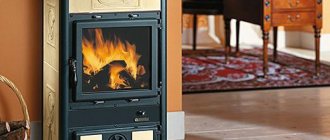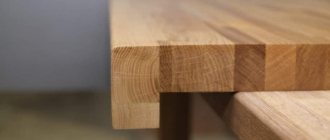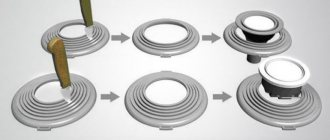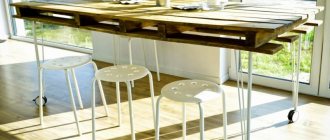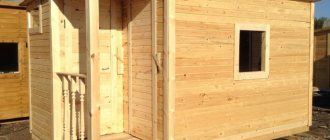Not all summer residents have the opportunity to make a full-fledged sewer system, and a developed environmental consciousness forces us to take care of waste recycling. The best option in this situation is a composting dry closet, in which waste is processed into compost. This article tells you how to make a dry closet with your own hands.
In the compost toilet bioreactor, waste is sprinkled with dry peat, which blocks odor and absorbs liquid. Biochemical reactions occur which cause the waste to decompose, releasing moisture and carbon dioxide and forming a small amount of compost.
It is this option that the summer residents of our portal consider the most harmless. Flush toilets require the use of chemical fluids.
Kisa Member of FORUMHOUSE
And in peat, besides peat and “this very thing,” there is nothing else.
Advantages and disadvantages
This type of toilet has a number of advantages:
- He has mobility. Since there is no need to use sewerage or water drainage, such a toilet can be installed in almost any necessary place.
- Cheap to install and use. Packages of peat for dressing are available for sale. For a small family, one such package can be enough for a year.
- During operation, no unpleasant odor is formed. This is due to the deodorizing ability of peat.
- It is possible to use such a toilet not only for a summer residence, but also in many cases where its mobility is important. One example would be a situation where a home is being renovated and the sewer system is temporarily turned off. In this case, a peat toilet may be one way to solve the problem.
- The consumable material (peat) does not harm the environment.
Peat is a natural material that can subsequently be used to fertilize the garden. Source agbz.ru
Processing waste to form compost, which can then be used as fertilizer.
However, they have some disadvantages:
- When using the toilet, it is necessary to ensure ventilation and drainage of liquid.
- Problems may arise when operating during the winter. For example, peat can freeze at low temperatures.
- A peat toilet is a fairly mobile option, but a portable dry toilet has even more compact dimensions.
A portable dry toilet is a more mobile option that you can take with you on the road. Source rosanneglass.co
Classification of composting toilets
These convenient devices can be classified depending on the characteristics of the work.
- Active models differ from passive ones in the presence of equipment for regulating the operating mode - thermostats, fans, heaters, etc. In active products, compost formation usually occurs throughout the year. In passive ones, the duration of the period depends on external factors, primarily on temperature, and can be about two years or more.
- Self-contained products are closed units, while designs with a remote composting unit can consist of several receptacles with toilet seats and one composting tank located at a certain distance.
- Bagged composting peat toilets are completely emptied after the chamber is filled. Continuous designs allow the finished compost to be recovered and used while the reservoir continues to be filled and waste converted. This operating principle can only be implemented for stationary models with large-volume storage devices.
Closets without a cesspool: the main types and their features
A drainage pit is considered the simplest and most cost-effective way to solve the problem with a toilet in a personal plot. Even so, there are limitations to this type of design. The installation of pit latrines is limited to the following conditions:
- the soil of the summer cottage consists of limestone or shale soil;
- groundwater passes too close to the surface;
- the toilet is expected to be used by a large number of people.
All these factors do not allow organizing a toilet based on a cesspool on the territory of a suburban area. The way out of this situation will be the construction of latrines of a completely different type, based on a different principle of operation.
Cabin for a homemade dry closet
Of course, if you wish, you can install a dry closet in your home with your own hands. But for this you will need a separate room with ventilation.
If more than one person uses the toilet, a drainage hose must be installed.
Those who cannot afford this will have to build a toilet on the street.
The house for it can be made of brick, wood or any material left over after the construction of the house. Instead of a wooden box for a seat, you can build a whole pedestal with two holes. And at the back or side of the house, attach a small door for removing the container.
More information on the topic: https://aqua-rmnt.com
Backlash closet
A backlash closet is a type of toilet connected to a sealed cesspool. The waste tank is located behind the foundation, to which it is connected directly or through an inclined pipe. It is equipped with a hatch through which it is convenient to clear waste. The bottom of the container is tilted towards the lid so that waste accumulates next to it
Unlike a traditional house with a cesspool, a backlash closet can be installed inside the house. This eliminates the need to additionally insulate the structure. This type of toilet is suitable for permanent use in houses without a sewer connection and is built without the possibility of further movement.
Ready-made solutions: overview
Today, both the most compact models and the most modern designs of increased comfort are in demand.
Let's consider the most popular domestic and foreign models:
- The inexpensive and compact Finnish model Piteco-505 is equipped with a drainage system and an electric fan. The volume of the storage tank is 44 liters, and the body is made of wear-resistant polypropylene. The advantages are represented by the presence of an automatic valve that closes the drainage hole, as well as a system for spreading peat and a separate storage tank.
- Domestic ventilated model Biocomfort-Plus , which resembles a traditional toilet in appearance and is distinguished by an ergonomic peat “flush”, as well as the presence of a dispenser button. The plastic body is resistant to aggressive environments, and the tank volume is 40 liters. The advantages of the design are represented by a ventilation pipe and a duct fan, as well as the presence of a separator.
- Domestic simple model Compact-Elite , equipped with a sealed peat “drain” and special pipe ventilation. The volume of the storage tank is 40 liters, and the body is made of high-strength modern plastics. The advantages include dosing and drainage systems, low weight and the presence of an outlet pipe for liquid fractions.
- Domestic model Compact Lux-M with a 60-liter storage tank and a polyethylene body that is highly resistant to adverse external factors. The main advantages are represented by a convenient “drain” dispenser and an effective ventilation system;
- Domestic model Compact-Premium , which is distinguished by the high efficiency of the drainage system. The body is made of thick and impact-resistant, modern plastics, and the volume of the reservoir for collecting waste is 60 liters. A design feature is the absence of drain holes and hoses.
- The Swedish model Separett Villa-9000 is characterized by compactness, aesthetics and high ergonomic design. The body is made of impact-resistant plastics. The ventilation system requires connection to the electrical network. The advantages of the model are represented by the presence of a child seat and an improved waste separation system.
- The Swedish model Violet Mulltoa-20 is a fully automatic unit, endowed with ergonomics and an attractive appearance. The body is made of frost-resistant and durable plastic. A distinctive feature of the design is the complete absence of a separation membrane and the presence of an automatic two-blade cutting mixer that crushes the waste.
Among the most original, but not very popular options is the Swedish model Separett Weekend-7011. The main disadvantage is the lack of effective ventilation.
When choosing a model, you need to pay attention to such parameters as the quality and resistance of the case to temperature changes, the presence of a sealed lid and ventilation system, as well as the volume of the storage tank.
Auxiliary products for dry toilets
In addition to the basic liquids, from time to time, cleaning, deodorizing and anti-freezing additives are introduced into the upper and lower chambers of the toilet. A good example of such drugs are the following drugs:
Deodorizing liquid for composting toilet Biola
Concentrate based on naturally degradable components. Does not harm the ecology of the site and human health. Removes unpleasant odors in a very short time. Therefore, Biola is used not only by owners of dry closets, but also by owners of country houses with amenities in the yard.
For a standard dry toilet with a sump volume of up to 50 liters, a one-time injection of 100 grams of the drug is sufficient, which is dissolved in 3 liters of water and poured into the upper tank or directly into the lower container. The procedure is repeated if necessary.
- Ingredients: surfactant complex, aromatic additive, targeted additives, dye, water
- Does not contain environmentally harmful substances: phosphates, phenols, acids, alkalis
- The product is available in liter bottles
- Price of the drug – from 400 rubles
Fermentation accelerator for composting toilets
BIOFORCE BioToilet Comfort
- a biologically active drug that increases concentration in the lower chamber of the dry closet. Accelerates the process of fermentation and breakdown of solid fractions of organic waste. Essentially, this drug cleans the lower chamber of solid deposits, separating them into liquid and gas. Recommended for use in case of increased load on the dry closet (unexpected arrival of guests, etc.).
- The packaging of BioToilet Comfort contains 20 sachets, each of which is designed for a volume of up to 20 liters.
- The bags are dumped into the lower chamber or dissolved in the drain tank
- The cost of packaging is 2200 rubles.
Thetford Bathroom Cleaner
a disinfectant for toilets and septic tanks, which has an antistatic effect and whitens treated surfaces. Helps maintain hygiene in areas where the dry closet is used. Unlike chlorine-containing and acid-based products, Bathroom Cleaner does not harm the seals and polymer body of the dry closet.
- Available in half-liter bottles with sprayer
- Cost – from 350 rubles
Which peat toilet to choose for your dacha
When choosing a composting toilet, pay attention to the following characteristics:
The dimensions of the product must correspond to the room allocated for installation. Pay special attention to the height of the toilet seat and take into account the needs of all family members. The frequency of cleaning depends on the volume of the storage tank
It is important to consider the number of people who will use the product, the frequency of use and the desired frequency of cleaning. Models with a fill sensor are especially convenient. This option allows you to accurately determine when the system needs to be cleaned. Seat load. Typically, ready-made models are designed for loads of up to 125 kg, but there are products that can withstand weights of up to 250 kg.
Let's look at some popular types of ready-made peat devices.
Ecomatic
This is a Finnish peat toilet with a large storage tank. The model uses a mixture of peat and sawdust as a filler. There is also a domestically produced Ecomatic model on sale. It has all the advantages of a Finnish product. In addition, the domestic model is equipped with a thermal seat, which increases the operating comfort of the device in the winter season. The price of an Ecomatic dry closet is in the range of $250-350.
Piteko
A Russian-made peat toilet does not need to be connected to a water supply or sewerage network. The compost bin has special doors that make it easier to unload. The model also has a special filtration system. The price of this product ranges from 91.7-116.7 dollars.
Biolan
This is another domestically produced model. The device has two chambers (for liquid and solid waste). Features of Biolan dry closets include an improved drainage system. These are quite expensive modifications, the price of which is in the range of $300-325.
Price comparison
Perhaps, after a detailed acquaintance with the main parameters and features of each dry closet model, readers of this article still have some doubts or questions. To dispel them, the table provides clarifying, more detailed characteristics and average cost, which will allow you to sway your choice in favor of one device or another.
| Model | Processing method | Storage tank volume, l | Dimensions, cm | Weight, kg | Average price, rub. |
| Thetford Porta Potti Qube 145 | chemical | 12 | 38.3x33x42.7 | 3,6 | 4350 |
| Enviro 10 | 20 | 41x35x42 | 4,3 | 4199 | |
| Bioforce Compact WC 12-20VD | 20 | 43.5x37x42 | 6 | 4997 | |
| Piteco 506 | compost peat | 44 | 39x59x70.6 | 8,2 | 5690 |
| Separett Camping 1165 | 23 | 67.2x43x54.1 | 4 | 6480 | |
| Thetford Porta Potti 565P | chemical | 21 | 33,8×44,8×45 | 5,3 | 10300 |
| Kekkila Ecomatic 50 | compost peat | 50 | 50x47x51 | 7 | 11680 |
| Separett Villa 9000 | electric | 23 | 45.6×54.1×67.2 | 13 | 43980 |
How to make a toilet in the country with your own hands: drawing and step-by-step instructions for creating a peat toilet
Peat toilets are no less popular among summer residents, as they can offer a lot of advantages to many owners of suburban areas. The method of sprinkling waste with peat substrate is justified by several advantageous advantages:
- Peat has good odor absorption capacity. With it you can forget about the unpleasant moments associated with using a restroom on the street.
- Due to the high level of hygroscopicity, the substrate absorbs moisture well, due to which the frequency of cleaning the drive can be reduced. In other words, the toilet can be used for a longer period without the need to empty the storage tank.
- The processed mixture can be used to fertilize the site, since peat, even in its pure form, contains bacteria that help convert organic waste into nutritious compost for the soil.
How to choose
When choosing a suitable option, you need to pay attention to various features of the offered models:
- When choosing, you need to consider the purpose for which you are purchasing a composting toilet for your dacha. If we are talking about a small family that rarely comes there, then a small volume is enough. A 10-15 liter tank may be suitable here. If there are always a lot of people there, it makes sense to buy a model with a large tank, for example, 100-150 liters or more.
- It is necessary to take into account the maximum weight the toilet seat can be designed for. Since the toilet is mobile, its strength is lower than that of a stationary one. If there are people in the house who have significant weight, the device should be selected in such a way that it can easily support it.
- If you buy inexpensive models, there is a risk that parts made of cheap plastic will quickly wear out and break. When purchasing such an important item for a long time, it would be wise to be guided, first of all, by high consumer qualities.
- If you plan to install the toilet in a specific place, then when purchasing you need to take its dimensions into account.
If there is a need to move the toilet, it is better to choose a more compact and mobile modelSource bio-park.ru
Different models can use different types of ventilation
For example, stationary models may require a hood. You need to pay attention to the quality of the material from which the toilet seat is made. It is convenient to use plastic that does not cool down immediately even at low temperatures. When choosing, you need to consider where it will be installed: indoors or outdoors
This affects the characteristics of ventilation and liquid drainage during operation.
Toilet cabin: Toypek
A portable, mobile model of a dry toilet, used in places where there is no sewerage system. Easy to assemble and transport if necessary. Gives you the opportunity to do all your “things” with comfort. It can be additionally equipped with a urinal, washbasin or pump for flushing sewage.
For its smooth operation, the following conditions must be met:
- Install only on a perfectly flat surface without any protrusions or slopes.
- Before you start using it, it is important to pour the deodorizing and disinfectant into the storage tank.
- Maintain the cabin and empty the tank regularly (at least once every seven days).
- Provide free access to specialized vehicles to empty the cabin.
- After each cleaning, pour a new portion of special liquid into the bottom of the storage container.
The material of the cabin and tray is durable, impact-resistant, but at the same time lightweight plastic. Due to this, it is not subject to corrosion and is easy to use. On the outside it is equipped with a door with a strong bolt, and inside, in addition to the storage tank, there is a comfortable seat with a large lid, a ventilation pipe, a coat hanger, and a toilet paper holder.
- Robust door closing mechanism with occupied/vacant indicator.
- Easy assembly, thanks to the material from which the cabin is made and the holes on the parts.
- High-quality casting of parts using state-of-the-art equipment.
- The colors of the cabins are resistant to fading in the sun and retain their brightness for a long time.
- They have a modern design and a wide range of surface colors.
- Low accuracy of parts, many mismatches in grooves.
- Poorly designed assembly instructions.
Toypek toilet cabin
Construction of a peat dry closet
From an aesthetic and visual point of view, a dry toilet is not much different from a regular toilet. Its design allows you to use it with comfort and convenience. A peat dry closet for a summer house or other building has the following design:
- Upper container. Used to store peat mixture in it. The peculiarity of the structure is that water is not used during operation. When you press the handle on the upper container, the mixture is poured into the lower container. The upper chamber in this case serves as a flushing system.
- Lower chamber, or storage tank. The average volume of a waste container is approximately 100-150 liters. This volume is sufficient for full use of the toilet by a family of 3-4 people. The lower container is necessary for collecting and accumulating human waste: feces and urine.
- Seat. Located above the lower chamber. Its main purpose is to create comfort and convenience during the operation of the structure.
- Ventilation. Like any room where there is a sewerage system, a dry closet must be equipped with a ventilation system. For this, the owners use a special pipe for ventilation. The ventilation kit for each model includes a clamp and a ventilation pipe.
General operating instructions
For the use of each individual type of dry closet there is its own instruction, which is included with the device.
In addition, there are several main points that are suitable for all models:
- First you need to assemble the structure according to the attached manual.
- Install it strictly on a flat, smooth surface in a heated room.
- After this, pour water and a disinfectant aromatic sanitary ware into the upper tank. Also pour some water and a waste decomposition agent into the lower tank (the amount of necessary liquid and additional substances for filling each of the tanks is written on the containers).
- You can find out about the filling of the lower compartment by looking at the indicator, if there is one, or “experimentally”.
- After the container is filled (preferably no more than 2/3), it is necessary to disconnect it, empty it (in a specially designated place), clean it, and put it back.
- For long-term storage, empty all containers, treat with special disinfectants, wipe dry, and put away.
It is important not to forget to fulfill all these simple requirements, and then any device will function smoothly.
Construction of a toilet for a summer house: drawing with dimensions for a “birdhouse” type structure
The design of the Birdhouse consists of wood, which can be covered with any other type of material. Construction of a single or gable roof is allowed. This type of closet is mounted as an above-ground building above the cesspool.
Typical design of a “Birdhouse” with dimensional parameters:
| Design element | Size, m |
| Rear wall (height) | 2 |
| Width | 1 |
| Front wall (height) | 2,3 |
| Base area | 1x1 |
When installing a wooden toilet structure, mandatory control of the placement of surfaces vertically and horizontally is necessary. For these purposes, it is recommended to use a building level.
What types of dry toilet designs are there?
The simplest dry closet consists of two combined containers. The upper one is a reception area and the lower one is for waste collection and disposal. To make the decomposition of human waste products faster, various filler compositions are used.
In addition to speeding up the recycling process, they destroy odors. Dry toilets are:
Now let's figure out which one you can build yourself.
The design of an electric dry closet is very complex, and it also requires power to operate.
Why do you need extra expenses?
Liquid composting toilets require a lot of water to use. You will have to think about how to drain excess liquid, and there will be a lot of it. The price of biological products that are used as fillers is also steep.
Using a liquid dry toilet results in high water consumption.
In addition, it needs to drain excess fluid
What do you need for a peat dry closet? The idea of installing such toilets is not new. Previously, something similar was called a powder closet. What was he like? The main part of this design was a container for collecting waste. After the need was relieved, it was necessary to “mask” everything with powder.
Sawdust, dry earth or ash were used for it.
Similar technology is still used today. Peat acts only as a powder or filler. Industrially manufactured structures have two combined containers. One is storage for waste, the other is for storing filler.
For homemade dry closets, two separate containers are often used. In addition to the simplicity of design, the peat dry closet has other advantages:
- does not pollute the environment;
- works without water;
- low price for consumables;
- obtaining high-quality natural fertilizer.
So, we decided: we’ll build a peat dry closet ourselves.
How to build a peat toilet for a summer house with your own hands?
DIY peat toilet (diagram)
Those who decide to build a composting toilet at their dacha must strictly follow the rule, which states that such a device must be placed as far as possible from sources of drinking and industrial water, as well as reservoirs (if there are any nearby). Do not allow toilet drainage to enter the water. The only exception here would be completely sealed toilets that guarantee safety for the environment.
You can build a peat dry closet yourself if you have a sealed container, which is most often used:
- Barrels;
- Buckets;
- Tanks;
- Sealed (waterproofed) cesspools.
The choice of container used depends on the required volume and the number of people using the peat dry closet.
Scheme of a simple peat toilet
The homemade device consists of:
- Containers;
- Box (most often wooden);
- Booths (“birdhouse”);
- Peat box;
- Seats.
The simplest homemade dry closet using peat is a wooden toilet seat with a vessel attached to it, which serves as a receiving container. To build this simple dry closet you will need the following materials:
Compost homemade toilet on a bucket
- Bucket-shaped container (volume - about 20 liters);
- Wooden block with a square cross-section (5 by 5);
- Plywood or chipboard (thickness - one and a half centimeters);
- Nails (screws).
The set of tools for construction will consist of:
- Roulettes;
- Jigsaw;
- Hammer;
- Screwdriver.
It is better to start constructing a simple device by cutting out parts of the required size:
Set of tools
- Legs (four bars 35 centimeters long);
- Side walls (two plywood rectangles 52 by 30 centimeters);
- Front and back walls (two plywood rectangles 45 by 30 centimeters);
- Cover (plywood rectangle 45 by 48 centimeters);
- Bar for loops (45 by 7 centimeters).
Next you need to assemble the device:
- Walls (short sides) are attached to the legs, which should protrude five centimeters on one side; Peat toilet diagram
- A bar for attaching hinges is screwed to the legs from the rear wall;
- A lid is attached to the bar using hinges;
- A round hole is cut out in the lid, corresponding in size to the diameter of a bucket (or a small twenty-liter barrel);
- The structure is sanded and treated with an antiseptic;
- A homemade or purchased toilet seat is placed directly above the hole.
Using the same principle, you can make a peat toilet with other containers. The difference will only be in volume and location. A compact peat dry toilet with a bucket can even be placed in a country house, but for a larger toilet you will most likely need a separate building and equipped drainage.
How to make a bathroom over a pit
I build a box from below according to the instructions for the simplest option. A hole is dug under the box, the bottom is made at an angle of twenty-five degrees. Pit parameters: length from two meters, width from one meter. The bottom of the pit is filled with concrete, the walls are laid out of brick.
Attention! Under the continuous toilet structure, a hole is dug with a sloped bottom.
The wall bordering the street should have a pair of holes located one above the other. The dimensions of the holes are such that you can easily remove the compost from below, and fill the container with peat through the top hole. These holes can be arranged in stages.
All parts are treated with bitumen to ensure waterproofing. A metal box is placed in one wall and a pipe is connected to it by welding to provide ventilation. A ventilation system is necessary to organize the supply of oxygen to microorganisms multiplying in peat, as well as to allow excess moisture to evaporate outside. Ventilation pipes must be installed strictly vertically; a mesh must be stretched over the area between the pipe and the structure to protect against insects. A layer of peat or earth up to 15 centimeters thick is placed at the bottom.
The operation of the toilet consists of the fact that, by removing part of the mature compost, the remaining mass of sewage mixed with bacteria falls down the slope. Therefore, the toilet does not require cleaning. The volume of the toilet is quite large, which affects the positive characteristics of the device. The frequency of peat extraction is reduced, and the layers below are heated to a higher quality.
The toilet can be used in winter; it does not have time to overflow, so you do not have to remove frozen compost. Comfortable conditions for creating fertilizer are created in the pit. The temperature inside can reach fifty degrees, which contributes to the death of harmful microbes. Also, the toilet maintains humidity, the presence of oxygen, and urea, which contributes to the rapid maturation of the compost.
When insulating a barrel with penofol, the waste breakdown process will take place during the cold period. If you install a film-type heater under the penofol, the process will speed up in the summer and continue in the winter.
Construction of a peat toilet
Peat toilets made independently are not much different from purchased ones, except in terms of the complexity of the device. To better understand the design installation system, you should carefully study the component parts and elements. So, a peat toilet for a summer house consists of the following parts:
- The seat is shaped like a box in a homemade device, and the purchased toilet looks like a toilet seat. In a home setting, an old chair can be used, which is upholstered with plywood or other materials, for example, chipboard or fiberboard. You can also create a small box with your own hands in which the container will be placed.
- A container for sewage, which is installed under the toilet seat. In purchased structures, plastic containers are used, and in private ones, a bucket or basin is used.
A container with peat for a country toilet
- A container for peat in a dry closet can be selected from old items, but you need to make sure that the material of the container is durable. You can install a separate bucket with a scoop and pour peat into it, or consider manual sprinkling.
- Compost pit - installed in outdoor buildings.
All elements are components of a peat toilet at a summer cottage. First of all, decide on the location of the building, which should be located away from the house. To build a toilet, you can use various materials that are left after the renovation. This will reduce waste on purchasing new ones.
How to install a dry closet inside the house
If there is a house on your site that lacks basic amenities, you can create them yourself. All that is required for this is chipboard, a stainless steel container, some tools, and beams with a cross section of 5x5 centimeters. You can regulate the size of the dry closet for your home yourself, but there are standards that are easy to adhere to. The length of the bars (there should be four of them) is 35 centimeters. Saw the chipboard into four rectangular pieces: two measuring 52x30 centimeters and two measuring 45x30 centimeters. The former are necessary for the side walls, the latter for the front and rear surfaces. It is also necessary to make a lid from one piece of chipboard 45x48 centimeters, and a hinge from a strip 45x7 centimeters.
Attach the formed pieces of chipboard to the beams one by one: they should protrude from the bottom side to form legs. After the walls are assembled, attach a bar on top to secure the lid, in which a hole should be made. To do this, place the receiving container you are going to use on it, upside down and draw a circle with a pencil in accordance with the diameter of the container. Using a suitable tool, cut a hole along the drawn line.
The dry closet is ready, but to make it look aesthetically pleasing, it is recommended to varnish or paint it. To ensure comfortable use for its intended purpose, install a toilet lid, which can be purchased at any hardware store. Don't forget to install a reservoir inside the box and fill it with peat.
As you can see, making a dry closet does not take much time and effort, and does not require large capital investments. By installing such a structure on your site or in a house, you will provide yourself with comfortable conditions for staying in the country.
Peat dry closet - operating principle and design
Dry, finely ground peat is poured into a peat dry closet in the part where a regular toilet contains water. This tank has a device for dispersing the substance, which is operated by a handle. After using the toilet, you need to twist the handle, the peat will scatter over the surface, blocking the waste, which will significantly reduce the smell. Because of this operating feature, a peat dry closet is also called a powder closet. Another name is composting toilets because the waste can be placed in a compost pit. True, another type of dry toilet belongs to this class - electric, which dries excrement.
The next name is dry dry toilets. Again, the name is associated with the method of waste disposal - dusting with dry peat. As a result of processing, the substance is also dry (or almost dry).
Peat is poured into the container at the top
Due to the high absorbency of peat, it absorbs part of the liquid component of the waste, and the rest is drained into a special tray below. From there, the liquid is discharged through a special drain hose. He is usually taken outside into a small pit.
The solid part of the waste is processed by bacteria contained in peat, which decompose organic matter. After processing, the container contains a mixture that is almost odorless. It can be safely poured onto a compost heap, that is, a peat toilet is an ideal dry closet for a summer residence. But the waste must remain on the heap for at least a year, or better yet, a couple of years.
The structure of a peat dry closet
Since complete recycling requires time to eliminate the characteristic smell of waste, a pipe must be attached to the peat dry closet (there is an outlet pipe; in some models, plastic pipes are included). If the draft is natural, the pipe is only straight, without elbows or bends, at least 2 meters high. If desired (if natural draft is not enough), you can install an exhaust fan. Then the requirements for the pipe are not so stringent.
Advantages
If you need a dry closet for your dacha, this is one of the best options - just a sea of advantages:
- The tank fills slowly - if there are 2-3 people living, the tank needs to be taken out once every 2-3 months.
- Peat consumption is small and it is inexpensive.
- Easy disposal - the container can be emptied into a compost heap, the contents are a homogeneous brown mass, without a sharp or specific odor. You can level it with a rake, the mass is quite loose, and after a couple of weeks it becomes overgrown with forbs.
- There is no smell when the ventilation is working normally.
- You can install it both in a separate toilet house and in the house.
- Tolerates freezing (if the plastic is frost-resistant).
Peat dry toilet for a summer residence: this is what a device for spreading peat looks like
Overall, a very good choice. Usually both the owners and neighbors are satisfied - there is no smell, no problems with processing. But you can’t do without minuses.
Flaws
The weak point of peat dry closets is the peat spreading device. Firstly, to ensure that the peat crumbles evenly, first turn the handle in one direction, then in the other. Secondly, it is not a fact that it will be scattered evenly. Often it is necessary to pour peat from the shovel reserve under the “hole”. This is where it gets worst of all, and all the waste is concentrated here. It is necessary to sprinkle them, so you also have to manually fill them.
Other disadvantages of peat toilets are:
- The drain hose for draining liquid waste is located quite high. Until the required level of liquid is collected in the pan, a significant period of time passes. And liquid waste also smells. To reduce the smell, you can periodically drain “manually” by tilting the toilet towards the drain.
- Solid waste accumulates under the hole. In order not to remove the tank ahead of time, the pile has to be moved aside. There is no particular smell, so it is not very uncomfortable.
- The waste container is heavy. It's difficult to bear it alone. If there are no assistants, you need to choose a model that has wheels. This makes it easier to transport the container. Sometimes it is necessary to add peat manually
- Need for ventilation. If this is a detached house, then even in the heat there are usually no problems - there are usually enough gaps in the structure for additional ventilation. If you install a peat dry closet in the dacha itself, in the house, you need a fan. In hot weather, it should work all the time to avoid smell.
- This type of dry closet requires permanent installation. You can carry them if you wish, but this is not a mobile option.
If we talk about the degree of convenience, this is a good choice, but only if it is possible to place it somewhere permanently. You can move the device, but each time you need to install an exhaust ventilation pipe.
What is a bio-toilet for a summer residence without odor and pumping?
A biological toilet is a small unit consisting of a simple flush tank and a vessel with bacteria. The principle of operation of a dry toilet for the home is as follows: the device utilizes waste materials through microorganisms contained in a special container. The design is tightly covered and, thanks to this, no unpleasant odors appear. To clean the dry closet, remove the waste container and remove its contents.
A complete sewage system in a summer cottage: mini-septic tanks
Agree that during the cold season or at night, no one particularly wants to get up and go somewhere outside to go to the toilet. Dry toilets and powder closets won’t help much either: after a while you’ll have to clean them and waste time on it. The most suitable option in such a situation would be to install a mini-septic tank on the site.
Types of mini-septic tanks
There are several types of mini-septic tanks, including both autonomous ones and those requiring a constant supply of electricity. Such septic tanks will be more environmentally friendly and safer for groundwater, since the filtration in them is much more thorough. The disadvantage of such a septic tank is the constant supply of electricity, which can lead to exceeding the limits when paying for electricity. Otherwise there are only positives. A mini-septic tank of this type will purify wastewater by 80-90%, which will allow it to be located near wells. You will also be pleased with the absence of an unpleasant odor.
An autonomous mini-septic tank will require pumping, so it will have to be located near the road so that the sewer truck can reach it with a 15-meter hose. Such a septic tank should not be located next to wells: there is a high probability of groundwater contamination.
Do-it-yourself autonomous mini-septic tank
Each summer resident can make an autonomous mini-septic tank with his own hands. To do this, you will need to buy 2-3 large barrels in the store (200-300 liters each, more is possible), as well as medium-diameter pipes. After this, you will need to make holes in the barrels for the barrels, as well as drill small holes in the bottom and in the walls so that the wastewater drains out faster. You can make holes only if there are no water wells nearby, and also if the groundwater lies at a depth of more than 5 meters. Then you should dig a hole for these barrels (tanks), at the bottom of which you will need to pour large pebbles and crushed stone to improve filtration. The next step is connecting the barrels together with pipes and burying them in the ground.
It is almost impossible to make an electric mini-septic tank yourself without specialized education. Therefore, it is better not to risk yourself and your loved ones - buy an electric mini-septic tank in a specialized store if it suits you better.
It is worth noting that a mini-septic tank is the most expensive option of all presented. You will also have to spend money on equipping the bathroom inside the house, as well as on bringing the pipes outside.
Selecting a location
When choosing the location of a peat toilet, it is taken into account whether summer residents live in the house all year round or visit the site only in the summer. If we are talking about summer use, then it is better to place the toilet on the site itself, building an attractive house for it. If people live in the country all year round, then it is better to place the toilet in a special room. Then there will be no need to insulate it during the cold season.
Attention : since there is no cesspool in the peat dry closet and, if it is used correctly, there are no unpleasant odors inside or outside the room, there is no need to adhere to special sanitary standards when placing it on the site. The main thing is to place the toilet stall in a convenient place and at least 1 m from the neighbor’s fence.
Despite all of the above, it is still not worth placing a peat toilet, built with your own hands, near a well with drinking water or in close proximity to a residential building.
Attention: even in such a toilet you should take care of a high-quality and reliable ventilation system.
Which toilet is better: a backlash closet with a cesspool
If you still haven’t decided which garden toilet is best for you, then think about the next option in the form of a backlash closet. The backlash closet is a regular village toilet with a cesspool underneath, only it is a modified version of it. The main thing in a backlash closet is the correct ventilation system.
This type of toilet is built in the same way as old village toilets, so there should be no problems with it. What is its advantage over a regular village toilet? The backlash closet has ventilation directly from the cesspool, so there will be practically no unpleasant smell in the closet.
The disadvantage of such a closet is the constant need for cleaning, which can only be done manually, despite all the unpleasantness of this process. It will not be possible to pump out this mass with a special machine, because it is too viscous. It is recommended to clean it at least once a year, preferably 2 times, especially if it is constantly used by 3 or more people. When constructing a backlash closet, a ventilation pipe is removed from the cesspool; it must be covered with a lid. This is done so that water from rain and melting snow does not get into the sump.
Project of a country toilet and shower under one roof
A toilet is good, but a toilet with a shower is even better. Both of these buildings create the comfort necessary in a dacha setting. By combining these designs you can save a little on material. Let's consider the project of a country toilet with a shower and its execution.
The toilet and shower have a common wall: this will help save on building materials
The proposed diagram shows that the toilet and shower have a common wall. This is the saving of building materials. This project is designed for the installation of a dry closet.
If a cesspool is used, the design is slightly modified.
To build such a structure, they first dig a foundation pit and strengthen its walls, and only then begin the construction of the building itself
Preparing the foundation for construction
First of all, a square pit with a side of 4 meters and 0.3 cm in depth is dug for the construction and covered with gravel to about 0.2 m.
After thoroughly compacting the base, formwork from wooden panels is knocked down for a foundation 0.3 m wide and 0.5 m high.
To make the foundation more durable, it is necessary to reinforce it
A sand-cement mortar is prepared and poured into the formwork.
Crushed stone is used as filler. When the concrete has set, remove the boards and cover the defects with mortar.
After removing the formwork, defective areas are sealed with mortar.
At the next stage, sewer pipes are installed.
Minuses
- If the storage tank is overfilled, removing it can cause some problems due to the fact that it becomes heavier. This problem is solved by choosing a model whose lower tank is equipped with wheels for transportation.
- The need for additional work to organize outlet openings for ventilation and the outlet pipe itself. Although, this problem can be solved by choosing a model with a drainage system.
- When sprinkling waste, it is possible that a layer of peat is laid unevenly on it, as a result of which it is necessary to carry out an additional step to level the bedding using a scoop.
Dry toilet for an elderly person
This device is especially important for people with special needs and their caregivers. After all, there is a big difference: sitting the patient on a bucket or on a comfortable toilet seat, and also, taking out the pan after each bowel movement or cleaning the lower tank of its contents a couple of times a month.
In addition, modern models are equipped with a lot of useful functions that will greatly facilitate the life of a disabled person or a seriously ill patient undergoing follow-up treatment in a home hospital: spraying an aromatic composition, seat heating, lighting, an automated lid that opens and closes at the press of a button, remote control, USB- connectors on the case for powering various small electrical devices.
